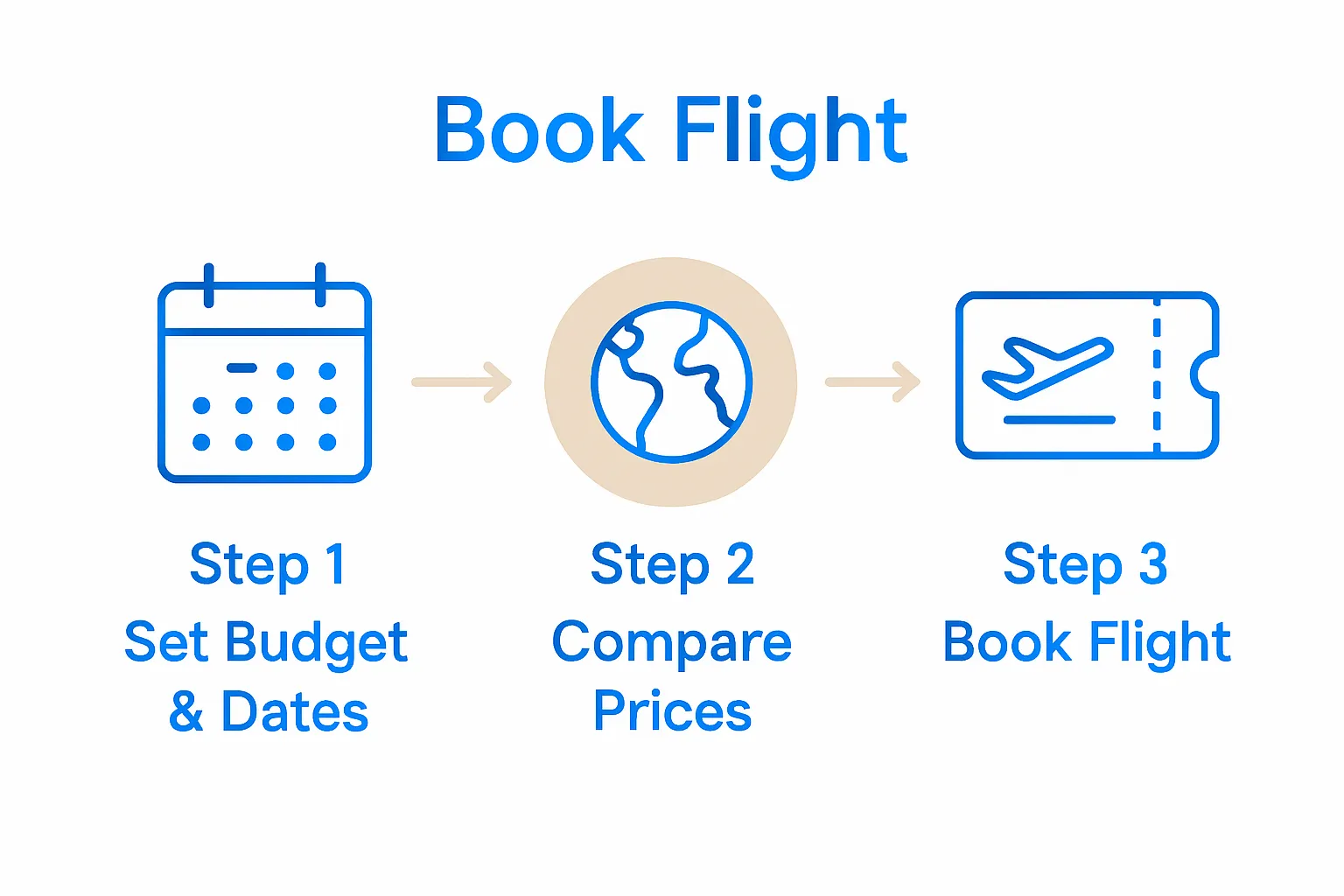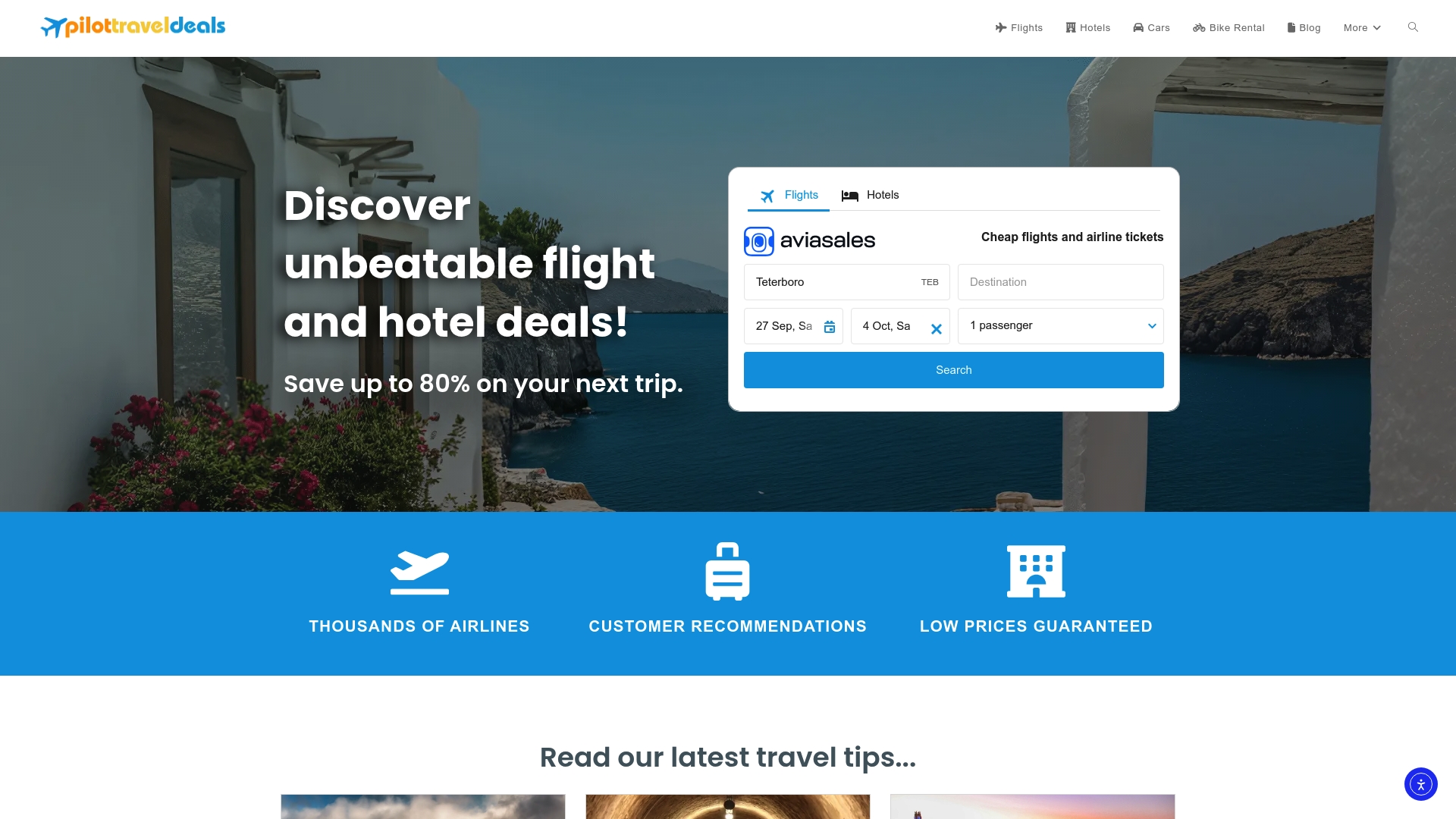Planning a trip can feel overwhelming, especially when flight prices change by the minute and small mistakes end up costing big. Travelers who set clear parameters from the start can actually save huge, with some experts advising you allocate 25-35 percent of your entire travel budget just for airfare. Most people focus only on finding the cheapest ticket, but that misses the real secret. The smartest travelers use flexible tools, creative date planning, and baggage knowledge to unlock deals most folks never see.
Table of Contents
- Step 1: Set Your Budget And Travel Dates
- Step 2: Research Flight Options And Compare Prices
- Step 3: Utilize Flexible Search Tools For Better Deals
- Step 4: Review Airlines And Their Baggage Policies
- Step 5: Complete Your Booking And Verify Details
Quick Summary
| Key Point | Explanation |
|---|---|
| 1. Set a clear flight budget. | Allocate 25-35% of your trip budget to airfare, including a buffer for price fluctuations. |
| 2. Use flexible travel dates. | Create a travel window of 3-5 days to increase savings; midweek flights often cost less. |
| 3. Compare multiple flight search platforms. | Use sites like Skyscanner and Google Flights to cross-reference prices for better deals. |
| 4. Understand airline baggage policies. | Review baggage rules carefully to avoid unexpected fees and ensure your luggage is compliant. |
| 5. Double-check booking details. | Verify all information on your booking confirmation for accuracy to prevent costly mistakes. |
Step 1: Set Your Budget and Travel Dates
Successful flight booking starts with two critical foundational elements: your financial boundaries and potential travel window. Establishing a clear budget and flexible travel dates will dramatically improve your chances of securing the most cost-effective flight options. This initial planning stage is about creating strategic parameters that transform random travel aspirations into achievable adventures.
Your budget isn’t just about how much money you can spend total. Break down your travel funds into specific flight allocation. Financial experts recommend dedicating approximately 25-35% of your total trip budget specifically to airfare. Pro tip: Always include a 10-15% buffer for unexpected expenses or potential price fluctuations. Consider your income, savings, and other financial commitments when determining this critical number.
Flexibility becomes your greatest ally when hunting for affordable flights. Instead of fixating on exact dates, create a potential travel window spanning 3-5 days before and after your ideal departure. Check out our comprehensive budget travel planning guide to understand how date flexibility can unlock significant savings. Midweek flights typically offer lower prices compared to weekend departures. Airlines often adjust pricing based on demand, with Tuesday and Wednesday generally presenting the most economical options.
Track your potential travel dates using digital tools like Google Flights or Skyscanner, which offer price comparison calendars. These platforms allow you to visualize pricing trends across multiple dates, helping you identify the most budget-friendly travel windows. Some travelers save hundreds by shifting their departure by just a few days.
Remember that your initial budget and date selection aren’t permanent contracts but strategic starting points. Remain open to adjustments and be prepared to compromise slightly on timing to maximize your financial efficiency. By establishing clear yet flexible parameters, you’re setting the stage for a successful, budget-conscious flight booking experience.
Step 2: Research Flight Options and Compare Prices
Comparing flight prices is an art form that requires strategic planning and smart digital navigation. Your goal in this phase is to uncover the most cost effective travel routes while maintaining flexibility and maximizing potential savings. Multiple search platforms are your primary weapons in this price hunting expedition.
Start by opening several flight comparison websites simultaneously. Platforms like Skyscanner, Google Flights, and Kayak offer comprehensive search capabilities that allow you to view pricing across different airlines and dates. Learn our recommended strategies for finding cheap flights to streamline your search process. Each platform uses slightly different algorithms, so cross referencing results can reveal hidden pricing opportunities that might be missed on a single site.
Utilize the incognito or private browsing mode when conducting flight searches. Websites track your browsing history and can potentially increase prices based on repeated searches. By using private browsing, you prevent these platforms from collecting data that might inflate pricing. Enable price alerts on these platforms to receive notifications when fares drop for your preferred routes.
Consider budget airlines and alternative airports as potential money saving options. Smaller regional airports or less popular carriers frequently offer significantly lower prices compared to major international airlines. Be cautious of additional fees for baggage, seat selection, or other services that might offset initial low ticket prices. Calculate the total travel cost including these potential extras to determine the most economical option.
Create a spreadsheet or use a dedicated travel tracking app to document your findings. Record flight prices, departure times, layover details, and total travel duration. This systematic approach helps you compare options objectively and identify the best value proposition. Remember that the cheapest flight isn’t always the best choice consider factors like total travel time, comfort, and convenience alongside pure pricing.
By the end of your research, you should have a comprehensive view of available flight options with clear pricing comparisons.
Below is a comparison table of popular flight search platforms mentioned, summarizing their unique features and best uses. This will help you quickly identify which tool to use for specific needs.
| Platform | Key Features | Best Use |
|---|---|---|
| Skyscanner | Multi-airline search, price alerts, flexible dates | Comparing broad options, finding cheap deals |
| Google Flights | Price calendar, Explore Destinations, price tracking | Visualizing price trends, flexible exploration |
| Kayak | Price predictions, multi-city, deals alert | Multi-city searches, monitoring fare drops |
| Airline Websites | Direct pricing, loyalty perks, exclusive deals | Booking direct, using airline points |
| Your success is measured by having at least three viable flight alternatives that meet your budget and scheduling requirements, providing you with the confidence to make an informed booking decision. |
Step 3: Utilize Flexible Search Tools for Better Deals
Mastering flexible search tools transforms your flight booking strategy from passive searching to active deal hunting. Flexibility is the secret weapon in securing extraordinary travel bargains. Modern digital platforms offer sophisticated search capabilities that go far beyond traditional booking methods, allowing travelers to uncover hidden pricing opportunities across multiple routes and dates.
Explore our comprehensive guide to finding cheap flights and learn how advanced search techniques can dramatically reduce your travel expenses. Google Flights offers an exceptional “Explore Destinations” feature that allows you to input your budget and see potential travel routes within your financial parameters. This tool visualizes pricing across global destinations, helping you discover unexpected and affordable travel opportunities you might have never considered.
Expand your search parameters by exploring nearby airports and alternative routes. Major metropolitan areas often have multiple airports within reasonable driving distance. A simple shift in departure location can yield substantial savings. For instance, flying out of a secondary airport 50 miles from your primary city might reduce ticket prices by 20-30%. Use mapping tools to calculate driving distances and factor in potential transportation costs to ensure the savings remain meaningful.
Subscribe to price tracking services and deal alert platforms that monitor flight pricing in real time. Websites like Skyscanner and Kayak offer price prediction algorithms that estimate whether current prices are likely to rise or fall. Some platforms provide color coded calendars showing the cheapest travel dates, enabling you to make data driven decisions about your travel timing. Set up customized alerts for your preferred routes to receive instant notifications about price drops or promotional fares.
Consider utilizing multi city search options which can sometimes produce cheaper overall travel costs compared to traditional round trip bookings. Advanced travelers often construct creative routing strategies that involve layovers or split ticket purchases to minimize expenses. This approach requires patience and strategic planning but can result in significant financial savings.
By the end of this research phase, you should have a comprehensive understanding of available pricing options, multiple potential travel routes, and a clear strategy for securing the most cost effective flights. Your success is measured by having developed a nuanced, flexible approach to flight searching that maximizes your potential savings.
Step 4: Review Airlines and Their Baggage Policies
Understanding airline baggage policies is a critical step in preventing unexpected fees and maintaining a smooth travel experience. Each airline operates with unique rules that can significantly impact your total travel cost. These policies extend far beyond simple weight restrictions, encompassing dimensions, quantity, and special item regulations that can catch unprepared travelers off guard.
Check our comprehensive guide on budget airline strategies to navigate the complex world of airline baggage requirements. Budget airlines typically have the most restrictive policies, often charging substantial fees for carry on and checked luggage. Some carriers offer basic fares that include only a small personal item, requiring additional payments for standard carry on bags. Calculate these potential extra expenses during your initial flight comparison to avoid surprise charges at the airport.
Determine your specific luggage needs before booking. Travelers should meticulously measure and weigh their intended luggage against each airline’s exact specifications. Most carriers provide detailed baggage dimensions on their websites, specifying exact measurements for carry on and checked bags. Pro tip: Purchase a lightweight, compact luggage set that meets multiple airlines’ standard size requirements. This strategy provides flexibility across different carriers and minimizes potential overweight or oversized baggage fees.
According to the Department of Transportation’s baggage guidelines, international and domestic flights often have dramatically different baggage allowances. Some international tickets include more generous baggage provisions, while domestic budget carriers might charge for every bag. Create a detailed inventory of items you plan to pack, then cross reference this list with the specific airline’s baggage policy. Pay special attention to restrictions on electronics, sports equipment, musical instruments, and other special items that might require additional documentation or incur extra fees.
Consider purchasing travel insurance or checking your credit card benefits for baggage protection. Some premium credit cards offer complimentary baggage fee reimbursement or coverage for lost luggage. This additional layer of protection can provide financial peace of mind and potential cost savings.
By the end of this research phase, you should have a comprehensive understanding of the baggage policies for your selected airlines.
 Your success is measured by having clear documentation of allowed luggage sizes, potential fees, and a strategic packing plan that minimizes additional expenses.
Your success is measured by having clear documentation of allowed luggage sizes, potential fees, and a strategic packing plan that minimizes additional expenses.
Step 5: Complete Your Booking and Verify Details
The final stage of flight booking requires meticulous attention to detail and strategic confirmation of every aspect of your travel arrangements. This critical step transforms your travel research into an actual confirmed journey. Your goal is to complete the booking process with precision, minimizing potential errors that could disrupt your travel plans.
Learn more about understanding travel deal verification to enhance your booking strategy. Before clicking the final confirmation button, carefully review every single detail on your booking page. Verify passenger names exactly as they appear on official identification documents. Even minor spelling discrepancies can create significant problems during check in, potentially requiring expensive ticket amendments or preventing travel altogether.
Examine your entire itinerary with forensic precision. Confirm departure and arrival airports, checking they match your intended destinations. Scrutinize flight times, ensuring they provide sufficient connection windows if you have multiple flights. Pay special attention to time zones and potential overnight layovers. Pro tip: Screenshot your entire booking confirmation and email it to yourself as a backup.
Select your seat strategically during the booking process. While some airlines charge additional fees for seat selection, choosing your seat in advance can significantly improve travel comfort. Consider factors like proximity to exits for extra legroom, avoiding middle seats if possible, and checking seating configurations for long haul flights. Some credit cards and frequent flyer memberships offer complimentary seat selection as a perk.
Protect your booking by purchasing travel insurance or checking existing coverage through credit card benefits. Many premium credit cards provide trip cancellation, interruption, and emergency assistance services. Understand the specific terms of your coverage, including what scenarios are included and any documentation requirements for potential claims.
After completing the booking, immediately take three crucial follow up actions. First, check your email for the confirmation and save the digital ticket. Second, add your flight details to your preferred calendar application with reminder alerts. Third, inform a trusted contact about your travel itinerary as a safety precaution.
Your booking is successfully completed when you have a confirmed digital ticket, have verified all travel details, and feel confident about your upcoming journey.
Use this checklist table to ensure you review each essential detail before finalizing your flight booking. It helps prevent common errors and guarantees a smooth booking experience.
| Step | What to Check | Why It Matters |
|---|---|---|
| Passenger Information | Names match ID/passport exactly | Avoids problems during check-in |
| Flight Itinerary | Departure/arrival airports and times | Ensures correct travel arrangements |
| Connection and Layover Times | Sufficient time between connecting flights | Prevents missed flights |
| Baggage Allowances | Carry-on and checked bag limits and fees | Avoids surprise costs at the airport |
| Confirmation Details | Saved booking email and travel calendar | Provides easy access and reminders |
 Trust your preparation and enjoy the anticipation of your upcoming travel adventure.
Trust your preparation and enjoy the anticipation of your upcoming travel adventure.
Ready to Book Smarter and Save More on Flights?
Tired of spending hours searching and still missing out on the best travel deals? The article shared expert advice on setting your budget, being flexible with dates, leveraging search tools, and decoding airline baggage rules. But even when you do everything right, so many flight booking sites feel overwhelming and make it hard to really save. At PilotTravelDeals.com, all those pain points disappear. Explore our Travel Tips for even more insider strategies and discover how our platform brings together the latest deals, genuine price comparisons, and planning shortcuts to help you avoid hidden fees and catch discounts that others overlook.

You have already learned how to prepare effectively—now let us help you save up to 80 percent off flights and travel essentials. Visit PilotTravelDeals.com today to find your next trip at an unbeatable price. Take control of your plans, put these booking tips into action, and see immediate results by booking direct through our site. Why wait? Your dream trip is just a click away.
Frequently Asked Questions
What is the best way to set a travel budget for flights?
Establish a specific portion of your total trip budget for airfare, ideally 25-35%, and include a 10-15% buffer for unexpected expenses.
How can I find the cheapest flights?
Utilize multiple flight comparison websites like Skyscanner or Google Flights, and search in incognito mode to avoid price inflation. Setting price alerts can also help catch fare drops.
What should I consider about airline baggage policies?
Airlines have varying baggage policies that may include fees for carry-ons and checked bags. Always review each airline’s specific regulations and measure your luggage to avoid unexpected charges.
How can I ensure my flight booking is confirmed correctly?
Before finalizing your booking, meticulously review all details such as passenger names, flight times, and itinerary. After confirming, save your booking confirmation and add your flight details to a calendar for reference.
Recommended
- Essential Tips for Finding Cheap Flights Effortlessly – PilotTravelDeals.com
- How to Find Cheap Flights for Your Next Adventure – PilotTravelDeals.com
- 10 Essential Budget Travel Tips for Smart Travelers – PilotTravelDeals.com
- 9 Hacks to Book a Room at the Cheapest Hotel – PilotTravelDeals.com
- 7 Smart Ways to Save on Airport Transfers




